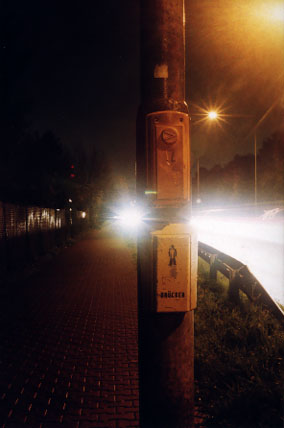 |
empty rooms / leere räume is based on audio recordings made in frankfurt during the course of august and september 2000 at traffic intersections and pedestrian crossings equipped with acoustic signals for the blind. excerpts from these recordings, each lasting between one second and two-and-a-half seconds, are played as repeating loops, with the sections slowly moving backwards in time from the end of the original recording to the beginning. in other words, each new loop begins and ends slightly earlier than the previous one, but lasts the same length of time. the process could be described in visual terms as "scanning a soundscape" and its time component as a movement from the future towards the past. the gradual changes that occur in the loops as a result of the slow scanning movement - different tempi within a range of milliseconds -freeze the trivial ambient noises in acoustic photographs, as it were. at the same time, this method emphasises their melodic and rhythmic qualities so that they become a structuring factor in the composition. the sound of the acoustic signal for blind pedestrians as an urban sonar at the heart of the recordings thus becomes a means of navigating the acoustic space in terms of rhythm and content. the composition was created using a computer programme specially written for the purpose. only loops and volume gradations were used, while sound design and pitch transposition were specifically avoided. the piece can be performed or reinvented live at the computer. this version was specially created for radio. | |
|
on the term 'radiopiece' |
||
|
"empty rooms / leere räume" is the title of the latest work by this Frankfurt composer (born 1955) in collaboration with Hessischer Rundfunk. The reference to John Cage and his "Empty Words" is surely no coincidence. In much the same spirit as the avant-garde New Yorker was able to conceive of a concert involving nothing more than going to a bus stop and listening to the sounds there, this student of Hubert Käppel, Klarenz Barlow and Johannes Fritsch set up his microphone at Frankfurt junctions. He specifically chose those junctions equipped with little yellow boxes at waist height to provide an acoustic signal for blind pedestrians to cross the street. The slow clack-clack of what Machnik calls the "urban sonar" speeds up to become a hectic clicking when the lights change, and it is this that forms the underlying motif in the 50-minute composition, processed as sound loops. The result is a kind of electro-acoustic scanning that moves forward gradually as it probes the background sounds, stretching and abbreviating the overall sound in carefully measured steps. After all, the blind pedestrian hears not only the continuous beat of the two-speed acoustic signal, but also countless other acoustic occurrences from the cars to the trams to snippets of conversation ("Komm mal hierher!" / "Come here" , "Was hast du gesagt?" / "What did you say?"). All this is captured and presented with the distinctively structured monotonous insistence that is an inherent feature of this great sound tonography. There are some wonderful domino effects when the fragmnents of sound combine in the style of an electro-acoustic "two steps forward, one step back" to create automatic chains of melody with slowly altered undercurrents and unforeseeable rhythmic polymetrics. Machnik's production, recently broadcast for the first time in the HR series "The Artist's Corner", is a perfectly functioning paradox: this unsighted school for the ears is an intensive course in touch for the listener's sense of hearing. |
||